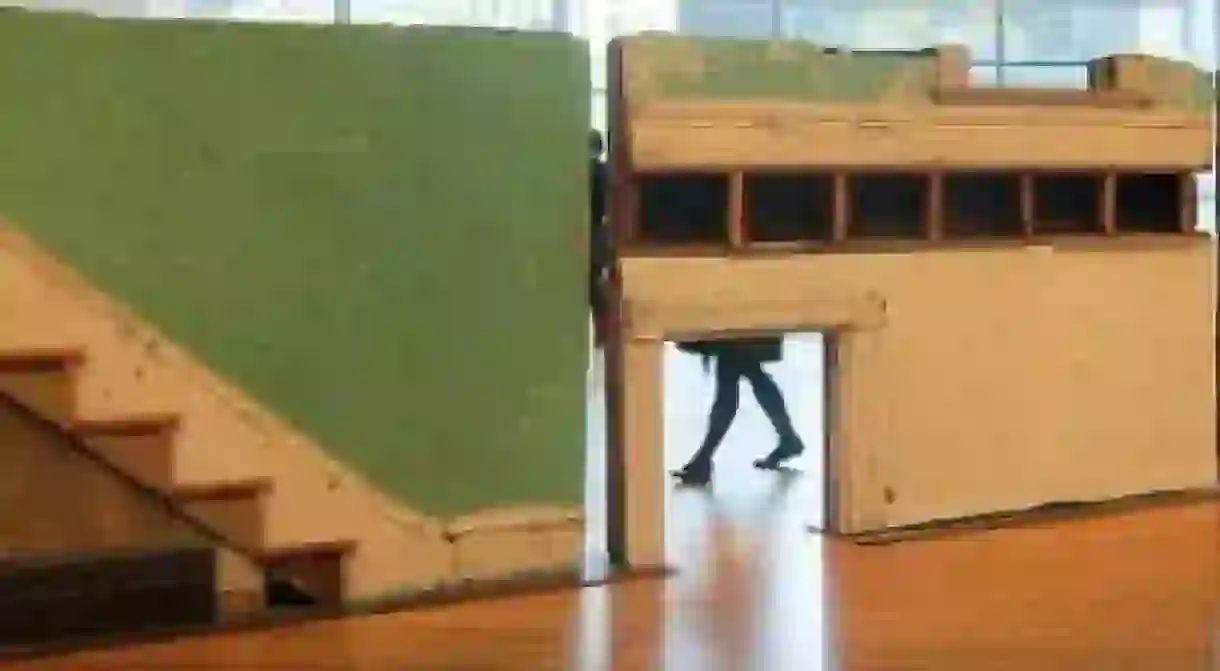Gordon Matta-Clark: The Artist & Anarchitecture

Anarchitecture, site-specific sculpture, and environmental art all have to pay homage to American artist Gordon Matta-Clark. Matta-Clark took steps to create not only profound art, but also art that was incredibly socially engaged. From his large-scale building projects to his short-lived restaurant, he revolutionized the art world.

The average person looks at an ancient, falling down ruin of a building and sees an eyesore, an unsightly blight on the neighborhood. A safety hazard best left to a bulldozer and wrecking ball. The more capitalizing sort might see the future site of a flashy new office high-rise or luxury condos. There are others though, who look at a run-down abandoned building, and see a work of art. American artist Gordon Matta-Clark saw this and something more in the peeling façades and sagging frames of these forgotten structures.
In 1968, after a stint at the Sorbonne and fresh out of Cornell with a B.A. in architecture, 25-year old Gordon Matta-Clark began practicing his craft by seemingly forgoing it altogether, instead throwing himself into other artistic endeavors like photography, film, video, performance art, drawing, photo collage, and sculpture. But far from leaving his schooling behind, Matta-Clark used these other mediums to execute and capture large-scale interventions in existing architecture. Anarchitecture, as the artistic-social movement was dubbed, sought to deconstruct architecture as a means to critique the excess and consumerism of society.
These site-specific works of art often made use of derelict buildings already scheduled for demolition. In Splitting (1974), Matta-Clark took a chain saw to a house in a New Jersey suburb and made a cut down the middle, literally splitting the house in two. A strip of sunlight ran through the center, bisecting the house and symbolizing the rupture of domestic space and breakdown of the family structure. Splitting, one of Matta-Clark’s first large-scale installations, is representative of the projects and their underlying social implications for which the artist is best known.

Of course, there are a number of problems associated with using a condemned structure as your canvas, those being principally that a) unpleasant run-ins with the authorities are bound to occur, and b) the total destruction of your creation is the eventual and unavoidable outcome. Naturally then, such works no longer exist in their original corporal forms for the public to enjoy. However, Matta-Clark made use of video, film, and photography to document his projects, and the vestiges of these works are available online. The MoMA alone currently has over 60 images, videos, and prints in its online collection. The Guggenheim has several works on view, including images of Conical Interest (1975), a project in which Matta-Clark made concentric cuts through two adjacent 17th century buildings in Paris, spiraling up at a 45 degree angle out through the roof. This opened up the rooms to sunlight and views of the environs while funneling the view from the street up through the guts of the buildings. As an Earth Art installation, the environment and the art is inextricably linked here and serves as a critique of the tyranny of urban enclosure and gentrification.
For Matta-Clark, the social implication of his creations was just as or more important than the artworks themselves. Conceptualism, in its elevation of ideas over aesthetics, was the order of the day among Matta-Clark and his avant-garde artist contemporaries. They applied this concept to an artist-run collective restaurant called FOOD, for which Matta-Clark designed the kitchen. It would seem that that Architecture degree came in handy after all. FOOD, alongside the collaborative exhibition space 112 Greene Street, was a meeting place for artists to gather, perform, create and display art. Though short-lived (1971-1973), FOOD was ahead of its time in many ways. Situated on the corner of Prince and Wooster Streets, it was an early settler of the artistic, bohemian SoHo of the 1970s and 80s. The restaurant was also a purveyor of fresh, seasonal produce, vegetarian dishes, and sushi at a time when such offerings were still mere novelties, quite unlike the over-saturated landscape of locally-sourced, farm-to-table, micro-sprouted vegan juice eateries of New York City today. Matta-Clark captured the day-to-day operations of the restaurant in a documentary, also called FOOD, that gives insight into the collective as both a functioning business and as a center of the counter-cultural artistic community of the time.
Gordon Matta-Clark’s legacy, though widely influential, is less extensive than it might be had the artist not died at the age of 35, a casualty of pancreatic cancer. Nevertheless, Matta-Clark’s contributions to anarchitecture, site-specific sculpture, and earth/environmental art more broadly, as well as his pioneering efforts in the artist-run experimental collective, are real and lasting. His body of work, as well as that of his contemporaries, has paved the way for countless other artists working to create art that goes beyond aesthetics to carry a greater message of social good. Matta-Clark gave life to structures destined for the scrap heap, and with their last breaths, we are reminded to pause and reflect on the way we think about and interact with the built environment around us.

By Olivia Edwards
Favorite pastimes include trying new food, traveling, reading, and obsessing over cute animals. A serial mover growing up, Olivia graduated from Berry College in Georgia in 2013 with a Master of Arts in International Studies and a double minor in French and Economics. She is now happy to call New York City home.













